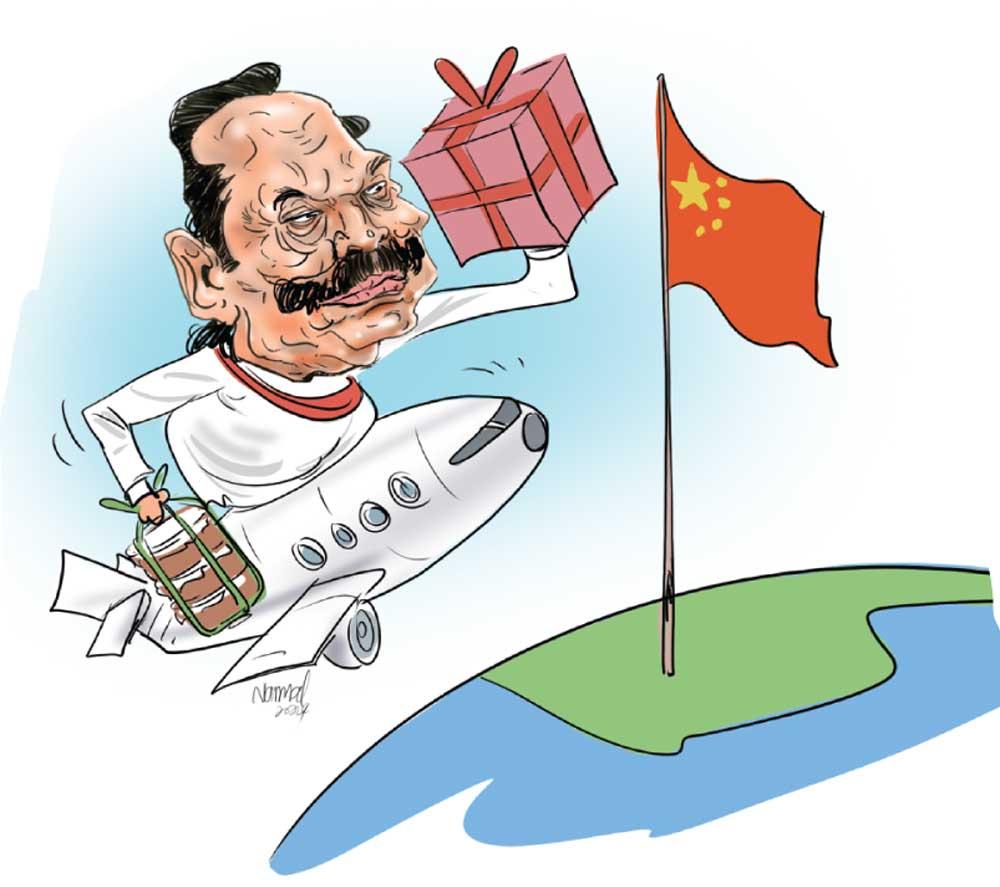Reply To:
Name - Reply Comment

 Former President Mahinda Rajapaksa last week visited China on a four-day visit during which, as local media reported, he was expected to “discuss Sri Lanka’s debt restructuring with Chinese Premier Li Qiang and Foreign Minister Wang Yi.”
Former President Mahinda Rajapaksa last week visited China on a four-day visit during which, as local media reported, he was expected to “discuss Sri Lanka’s debt restructuring with Chinese Premier Li Qiang and Foreign Minister Wang Yi.”
The discussions were also expected to “cover potential development projects beneficial to Sri Lanka and convey gratitude for China’s support.”
In which capacity Rajapaksa would negotiate on behalf of Sri Lanka has been a moot point:
He is only a Member of Parliament, and there was no mention of him being a special envoy of the President or the Government of Sri Lanka.
Considering that his party, Sri Lanka Podujana Peramuna (SLPP), is still the key backer of the incumbent president, though a good part of SLPP MPs who aligned with Wickremesinghe seemed to have broken ranks with the Rajapaksas, he still has some clout. However, he is also loathed by a large portion of the Sri Lankan public, who blame him for the economic crisis, though he is surely not the only one responsible.
Commemoration ceremony
Rajapaksa visited China to participate in the commemoration ceremony of the 70th anniversary of the five principles of peaceful co-existence, which was also attended by former political leaders from countries including Vietnam, Myanmar, Laos, Thailand, Indonesia, the Maldives, Egypt, Ethiopia, South Africa, Kyrgyzstan, Moldova, Brazil, Guyana, Japan, Republic of Korea, Italy, France, Croatia and Slovenia, representatives of international/regional organisations, and diplomatic envoys and academics, according to a communique issued at the end of the conference.
He was photographed shaking hands with Chinese President Xi Jinping and was also visited by Vice Foreign Minister Sun Weidong. (Unlike most other countries, China has five vice foreign ministers). There was no mention of him holding one-on-one discussions on debt restructuring with China’s Prime Minister Li Qiang or Foreign Minister Wang Yi. Probably that was redundant since last week, the government announced a debt restructuring deal with Paris Club, India and China, as well as China’s Exim Bank.
The Five Principles of Peaceful Co-existence is the central pillar of China’s official foreign policy, first announced by China’s first Prime Minister, Zhou Enlai, in 1954 to assuage the concerns of China’s neighbours.
During the early years of the founding of the PRC, China’s new Communist rulers distrusted the bourgeois elites of newly independent former colonies and rejected ‘non-alignment’ as ‘reactionary’. Suspicion was mutual, and the native elites in India, Pakistan, Indonesia, Myanmar, and even Sri Lanka, who shared similar grievances of colonialism as China did, were still wary of China’s professed goal of promoting the worldwide revolution and attempts to sow discord in their countries.
At the end of the Korean War, as war-weary China faced growing international isolation, Zhou announced the Five Principles, marking a shift from China’s initial highly doctrinaire worldview.
The five principles of peaceful co-existence are mutual respect for sovereignty and territorial integrity, mutual non-aggression, mutual non-interference in each other’s internal affairs, equality and mutual benefit, and peaceful co-existence.
The five principles, known as “Panchaseela” in Nehru’s India, reassured China’s peaceful intentions and were later incorporated into the Sino-India agreement on trade in Tibet and the Sino-Burma agreement. This also made communist China more palatable to other Asian countries, paving the way for diplomatic relations with countries such as Nepal in 1955 and Sri Lanka under S.W.R.D. Bandaranaike government in 1957.
Though China-India bonhomie collapsed after the border war in 1962, the bilateral partnerships, founded on five principles, saw most Asian states espousing a position of ‘neutrality’ during the conflict.
High and Lows
The height of the Sino-Sri Lankan relationship is none other than the two-term Presidency of Mahinda Rajapaksa, during which China was the key backer of the government’s military campaign against terrorism and later the key lender and diplomatic partner at the international forums.
During the same period, Sino-Sri Lanka relations were upgraded to a strategic partnership, high on the ladder in the importance China pays to a bilateral partnership, a tad below ‘an All-weather partnership that defines its relations with Pakistan.
It had been fashionable, some time back, to blame Chinese loans erroneously for Sri Lanka’s sovereign debt crisis, though the reckless commercial borrowing in the form of International Sovereign Bonds was the culprit. There is no gainsaying that Chinese loans were the primary catalyst in transforming Sri Lanka’s infrastructure landscape. Only a partisan fool would overlook the long-held infrastructure backlog in this country at the turn of the 2000s and the persistent official apathy and dramatic transformation that followed, bankrolled by China during the next 15 years, which by most standards did the catch-up with the past 30 years of under-investment in infrastructure. It is a shame that Mahinda Rajapaksa, who ushered in that revolution, singularly failed to introduce necessary structural reforms to make full use of these new roads, ports and infrastructure to turbo-charge the economy. Perhaps he listened too much to his caveman economists, trusted wheeler dealers and insular nationalists and paid the price.
The fall of the Rajapaksas also strained Sri Lanka’s relations with China. Though Beijing claims that it conducts foreign relations with countries and not personalities, it, in fact, invests heavily, just like any other country would do, in personal relationships. Mahinda Rajapaksa was not just China’s man in Sri Lanka, but given his monopolisation of power of the state around him and his family, Sri Lanka’s relations with China were seen as an extension of the Rajapaksa regime. This personalisation and politicisation of the bilateral relationship and China’s economic diplomacy later resulted in the suspension of some key Chinese projects, such as Colombo Port City, at the advent of the Yahapalanaya.
Similarly, the downfall of the Rajapaksas has now dampened the bilateral relationship. That is sad, considering China is one of the two key bilateral relations of Sri Lanka, the other being India.
These two relationships would gain added strategic importance when the global power transition further deepens in the coming decades. No matter what the naysayers bet on, the US$ 17.5 trillion Chinese economy growing at a modest 4-5 per cent would contribute to the bulk of global growth for the coming decades. Sri Lanka should strive to cash on this windfall and the proliferation of China-centric supply chains out of the Mainland.
False binaries
In order to do that, Sri Lanka should get over the false binaries that have always hamstrung its foreign relations. False binaries make the leaders think the relations with one country come at the expense of the other, making countries pick either of great powers at the cost of the other.
This has been a salient flaw in the Rajapaksa foreign policy, whose relations with China came at the expense of the West. But also, to some degree, the same fallacies persist in Ranil Wickremesinghe’s foreign policy, whose relationship with the West and India seems to come at the expense of long-cultivated ties with China. (No one knows what Sajith Premadasa or JVP thinks!)
The often-exaggerated dilemma of navigating between two great powers is actually complicated by these domestic follies of self-seeking leaders and much less by systemic concerns.
Sri Lanka should rebuild its relationship with China and do it urgently. It should recognise the Sino-Sri Lanka relations as a priority in the country’s foreign relations.
On China’s part, it should move past the Rajapaksas. Being seen with the Rajapaksas is now a liability and would make many millions of Sri Lankans think of it as an extension of the discarded old regime.
Follow @RangaJayasuriya on X